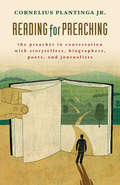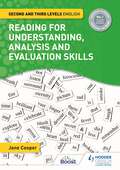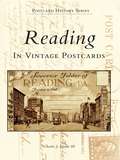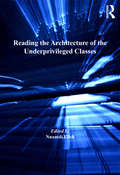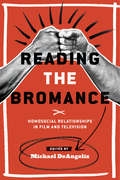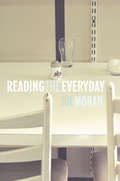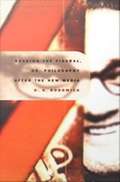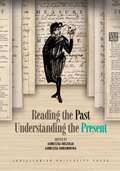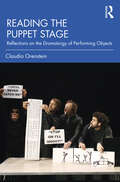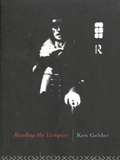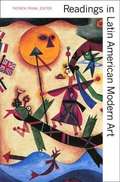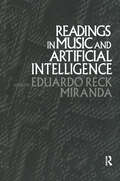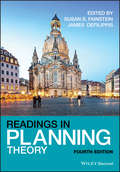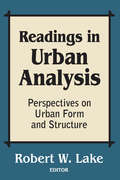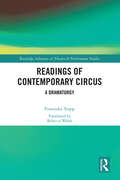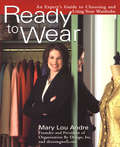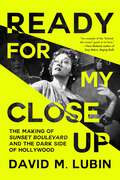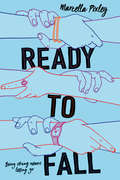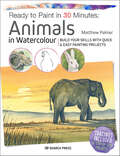- Table View
- List View
Reading between Designs: Visual Imagery and the Generation of Meaning in The Avengers, The Prisoner, and Doctor Who
by Piers D. Britton Simon J. BarkerFrom the alien worlds of Star Trek to the realistic operating room of ER, the design of sets and costumes contributes not only to the look and mood of television shows, but even more importantly to the creation of memorable characters. Yet, until now, this crucial aspect of television creativity has received little critical attention, despite the ongoing interest in production design within the closely allied discipline of film studies.<P><P>In this book, Piers Britton and Simon Barker offer a first analytical study of scenic and costume design for television drama series. They focus on three enduringly popular series of the 1960s--The Avengers, The Prisoner, and Doctor Who--and discuss such topics as the sartorial image of Steed in The Avengers, the juxtaposition of picturesque and fascistic architecture in The Prisoner, and the evolution of the high-tech interior of Doctor Who's TARDIS. Interviews with the series' original designers and reproductions of their original drawings complement the authors' analysis, which sheds new light on a variety of issues, from the discourse of fashion to that of the heritage industry, notions of "Pop" and retro, and the cultural preoccupation with realism and virtual reality.
Reading for Preaching: The Preacher in Conversation with Storytellers, Biographers, Poets, and Journalists
by Cornelius Plantinga Jr.In Reading for Preaching Cornelius Plantinga makes a striking claim: preachers who read widely will most likely become better preachers.Plantinga -- himself a master preacher -- shows how a wide reading program can benefit preachers. First, he says, good reading generates delight, and the preacher who enters the world of delight goes with God. Good reading can also help tune the preacher’s ear for language -- his or her primary tool. General reading can enlarge the preacher’s sympathies for people and situations that she or he had previously known nothing about. And, above all, the preacher who reads widely has the chance to become wise.This beautifully written book will benefit not just preachers but anyone interested in the wisdom to be derived from reading.Works that Plantinga interacts with in the book includeThe Kite Runner, by Khaled HosseiniEnrique's Journey, by Sonia NazarioSilence, by Shusaku Endo"How Much Land Does a Man Need?" by Leo Tolstoy"Narcissus Leaves the Pool" by Joseph EpsteinLes Miserables, by Victor Hugo. . . and many more!
Reading for Understanding, Analysis and Evaluation Skills: Second And Third Levels English
by Jane CooperSyllabus: CfE (Curriculum for Excellence, from Education Scotland) and SQALevel: BGE S1-3: Third & Fourth LevelsSubject: EnglishCapture pupils' imagination and attention with a rich collection of quality texts, handpicked by Jane Cooper to ensure that pupils want to start reading - and keep reading.Tailored to the interests, motivations and abilities of pupils working towards Second and Third Levels in S1 to S3, this book will help you to close the attainment gap.> Unlock a world of meaning, connection and questioning. Part One teaches the close reading skills that pupils need throughout their lives, with simple explanations, lots of examples and tasks set at three levels - 'Building', 'Strengthening' and 'Extending'.> Apply and develop RUAE skills and monitor progress. Part Two contains ten practice assessments that gradually increase in difficulty, with longer passages, more complex language and more challenging questions.> Save time sourcing non-fiction text extracts. Drawing on her long career as an English teacher and author, Jane Cooper has a talent for knowing which topics pupils will find curious or fun - from the world's cheesiest pizza to a mysterious metal column that appeared in a desert.> Build the foundations for success in National qualifications. With Course Reports showing that N5 and Higher students most commonly lose marks in the RUAE papers, this book offers a proactive solution to building confidence and skills during BGE.> Support the individual needs of every pupil. Providing differentiated, age-appropriate content and tasks, this is the perfect resource for mixed-ability classrooms - especially when used alongside its companion volume, Levels 3-4 English: Reading for Understanding, Analysis and Evaluation Skills.
Reading for Understanding, Analysis and Evaluation Skills: Second And Third Levels English
by Jane CooperSyllabus: CfE (Curriculum for Excellence, from Education Scotland) and SQALevel: BGE S1-3: Third & Fourth LevelsSubject: EnglishCapture pupils' imagination and attention with a rich collection of quality texts, handpicked by Jane Cooper to ensure that pupils want to start reading - and keep reading.Tailored to the interests, motivations and abilities of pupils working towards Second and Third Levels in S1 to S3, this book will help you to close the attainment gap.> Unlock a world of meaning, connection and questioning. Part One teaches the close reading skills that pupils need throughout their lives, with simple explanations, lots of examples and tasks set at three levels - 'Building', 'Strengthening' and 'Extending'.> Apply and develop RUAE skills and monitor progress. Part Two contains ten practice assessments that gradually increase in difficulty, with longer passages, more complex language and more challenging questions.> Save time sourcing non-fiction text extracts. Drawing on her long career as an English teacher and author, Jane Cooper has a talent for knowing which topics pupils will find curious or fun - from the world's cheesiest pizza to a mysterious metal column that appeared in a desert.> Build the foundations for success in National qualifications. With Course Reports showing that N5 and Higher students most commonly lose marks in the RUAE papers, this book offers a proactive solution to building confidence and skills during BGE.> Support the individual needs of every pupil. Providing differentiated, age-appropriate content and tasks, this is the perfect resource for mixed-ability classrooms - especially when used alongside its companion volume, Levels 3-4 English: Reading for Understanding, Analysis and Evaluation Skills.
Reading in Vintage Postcards (Postcard History)
by Charles J. Adams IIIIn the mid-nineteenth century, a transportation industry developed in Reading that put the city on the map--and on the Monopoly board--forever. Founded in 1748 by William Penn's sons Thomas and Richard,Reading experienced rapid growth throughout the nineteenth century as the Reading Railroad (the Philadelphia and Reading Railroad) breathed steam into the city's industry. As the powerful railroads faded later, so did the city's economy. In recent years, Reading has become known as the birthplace and capital of factory outlet shopping and the hub ofnewborn manufacturing, financial, and agricultural enterprises.
Reading the Architecture of the Underprivileged Classes
by Nnamdi EllehThe expansion of cities in the late C19th and middle part of the C20th in the developing and the emerging economies of the world has one major urban corollary: it caused the proliferation of unplanned parts of the cities that are identified by a plethora of terminologies such as bidonville, favela, ghetto, informal settlements, and shantytown. Often, the dwellings in such settlements are described as shacks, architecture of necessity, and architecture of everyday experience in the modern and the contemporary metropolis. This volume argues that the types of structures and settlements built by people who do not have access to architectural services in many cities in the developing parts of the world evolved simultaneously with the types of buildings that are celebrated in architecture textbooks as 'modernism.' It not only shows how architects can learn from traditional or vernacular dwellings in order to create habitations for the people of low-income groups in public housing scenarios, but also demonstrates how the architecture of the economically underprivileged classes goes beyond culturally-inspired tectonic interpretations of vernacular traditions by architects for high profile clients. Moreover, the essays explore how the resourceful dwellings of the underprivileged inhabitants of the great cities in developing parts of the world pioneered certain concepts of modernism and contemporary design practices such as sustainable and de-constructivist design. Using projects from Africa, Asia, South and Central America, as well as Austria and the USA, this volume interrogates and brings to the attention of academics, students, and practitioners of architecture, the deliberate disqualification of the modern architecture produced by the urban poor in different parts of the world.
Reading the Bromance: Homosocial Relationships in Film and Television
by Michael DeangelisIn the middle of this century's first decade, "bromance" emerged as a term denoting an emotionally intense bond between straight men. Yet bromance requires an expression of intimacy that always toys with being coded as something other than "straight" male behavior, even as it insists that such intimacy must never be misinterpreted. In Reading the Bromance: Homosocial Relationships in Film and Television, editor Michael DeAngelis has compiled a diverse group of essays that address the rise of this tricky phenomenon and explore the social and cultural functions it serves. Contributors consider selected contemporary film and television texts, as well as the genres that historically inspired them, in order to explore what needs bromance attempts to fulfill in relationships between men--straight or otherwise. Essays analyze films ranging from I Love You, Man to Superbad, Humpday, I Now Pronounce You Chuck and Larry, The Hangover, and the Jackass films, and include studies of representative examples in international cinema such as Y tu mama tambien and classic and contemporary films of the Bollywood genre. The volume also examines the increasingly prevalent appearance of the bromance phenomenon in television narratives, from the "male bonding" rituals of Friends and Seinfeld to more recent manifestations in House, The Wire, and the MTV reality series Bromance. From historical analysis to discourse analysis, sociological analysis, and queer theory, this volume provides a broad range of methodological and theoretical approaches to the phenomenon in the first booklength study of the bromance genre. Film and television scholars as well as readers interested in pop culture and queer studies will enjoy the insights of Reading the Bromance.
Reading the Everyday
by Joe MoranIn an ever-growing field of study, this is a major contribution to one of the key areas in cultural studies and cultural theory – the spaces, practices and mythologies of our everyday culture. Drawing on the work of such continental theorists as Henri Lefebvre, Michel de Certeau, Marc Augé and Siegfried Kracauer, Joe Moran explores the concrete sites and routines of everyday life and how they are represented through political discourse, news media, material culture, photography, reality TV shows, CCTV and much more. Unique in his focus of the under-explored, banal aspects of everyday culture, including office life, commuting, traffic and mass housing, Moran re-evaluates conventional notions of everyday life in cultural studies, and shows that analysing such ‘boring’ phenomena can help make sense of cultural and social change. This book is interdisciplinary in its approach and covers many different areas including visual culture, cultural geography, material culture, and cultural history as well as the key areas of cultural studies and sociology. Students from all these subjects will find this clearly written and lively work an invaluable study resource.
Reading the Figural: Or, Philosophy After the New Media
by D. N. RodowickIn Reading the Figural, or, Philosophy after the New Media D. N. Rodowick applies the concept of "the figural" to a variety of philosophical and aesthetic issues. Inspired by the aesthetic philosophy of Jean-Franois Lyotard, the figural defines a semiotic regime where the distinction between linguistic and plastic representation breaks down. This opposition, which has been the philosophical foundation of aesthetics since the eighteenth century, has been explicitly challenged by the new electronic, televisual, and digital media. Rodowick--one of the foremost film theorists writing today--contemplates this challenge, describing and critiquing the new regime of signs and new ways of thinking that such media have inaugurated. To fully comprehend the emergence of the figural requires a genealogical critique of the aesthetic, Rodowick claims. Seeking allies in this effort to deconstruct the opposition of word and image and to create new concepts for comprehending the figural, he journeys through a range of philosophical writings: Thierry Kuntzel and Marie-Claire Ropars-Wuilleumier on film theory; Jacques Derrida on the deconstruction of the aesthetic; Siegfried Kracauer and Walter Benjamin on the historical image as a utopian force in photography and film; and Gilles Deleuze and Michel Foucault on the emergence of the figural as both a semiotic regime and a new stratagem of power coincident with the appearance of digital phenomena and of societies of control. Scholars of philosophy, film theory, cultural criticism, new media, and art history will be interested in the original and sophisticated insights found in this book.
Reading the Past, Understanding the Present
by Agnieszka Orszulak Agnieszka RomanowskaReading the Past, Understanding the Present is a collection of essays written by students from nine European universities, who took part in the Strategic Partnership, “Facing Europe in Crisis: Shakespeare’s World and Present Challenges,” aiming to promote historical understanding of the crises plaguing the contemporary Europe and the world. In each chapter, the authors examine early modern theatre, the works by William Shakespeare in particular, and how it interacts with various local and global issues, reflecting on their cultural and socio-political origins and consequences. This book offers an innovative insight into the relationship between the past represented in such plays as The Merchant of Venice, King Lear, The Tempest</i, or the history plays and the complex contemporary European context – migrant crisis, racial diversity, democracy, or the Covid-19 pandemic.
Reading the Puppet Stage: Reflections on the Dramaturgy of Performing Objects
by Claudia OrensteinDrawing on the author’s two decades of seeing, writing on, and teaching about puppetry from a critical perspective, this book offers a collection of insights into how we watch, understand, and appreciate puppetry. Reading the Puppet Stage uses examples from a broad range of puppetry genres, from Broadway shows and the Muppets to the rich field of international contemporary performing object experimentation to the wealth of Asian puppet traditions, as it illustrates the ways performing objects can create and structure meaning and the dramaturgical interplay between puppets, performers, and language onstage. An introductory approach for students, critics, and artists, this book underlines where significant artistic concerns lie in puppetry and outlines the supportive networks and resources that shape the community of those who make, watch, and love this ever-developing art.
Reading the Silver Screen: A Film Lover's Guide to Decoding the Art Form That Moves
by Thomas C. FosterFrom the New York Times bestselling author of How to Read Literature Like a Professor comes an indispensable analysis of our most celebrated medium, film.No art form is as instantly and continuously gratifying as film. When the house lights go down and the lion roars, we settle in to be shocked, frightened, elated, moved, and thrilled. We expect magic. While we're being exhilarated and terrified, our minds are also processing data of all sorts--visual, linguistic, auditory, spatial--to collaborate in the construction of meaning.Thomas C. Foster's Reading the Silver Screen will show movie buffs, students of film, and even aspiring screenwriters and directors how to transition from merely being viewers to becoming accomplished readers of this great medium. Beginning with the grammar of film, Foster demonstrates how every art form has a grammar, a set of practices and if-then propositions that amount to rules. He goes on to explain how the language of film enables movies to communicate the purpose behind their stories and the messages they are striving to convey to audiences by following and occasionally breaking these rules.Using the investigative approach readers love in How to Read Literature Like a Professor, Foster examines this grammar of film through various classic and current movies both foreign and domestic, with special recourse to the "AFI 100 Years-100 Movies" lists. The categories are idiosyncratic yet revealing. In Reading the Silver Screen, readers will gain the expertise and confidence to glean all they can from the movies they love.
Reading the Vampire (Popular Fictions Series)
by Ken GelderInsatiable bloodlust, dangerous sexualities, the horror of the undead, uncharted Trannsylvanian wildernesses, and a morbid fascination with the `other': the legend of the vampire continues to haunt popular imagination.Reading the Vampire examines the vampire in all its various manifestations and cultural meanings. Ken Gelder investigates vampire narratives in literature and in film, from early vampire stories like Sheridan Le Fanu's `lesbian vampire' tale Carmilla and Bram Stoker's Dracula, the most famous vampire narrative of all, to contemporary American vampire blockbusters by Stephen King and others, the vampire chronicles of Anne Rice, `post-Ceausescu' vampire narratives, and films such as FW Murnau's Nosferatu and Bram Stoker's Dracula.Reading the Vampire embeds vampires in their cultural contexts, showing vampire narratives feeding off the anxieties and fascinations of their times: from the nineteenth century perils of tourism, issues of colonialism and national identity, and obsessions with sex and death, to the `queer' identity of the vampire or current vampiric metaphors for dangerous exchanges of bodily fluids and AIDS.
Reading's Big League Exhibition Games (Images of Baseball)
by Charles J. Adams III Brian C. Engelhardt Dr David VoigtWhile Reading may be known today for the Fightin' Phils, it has also been the site of 72 games played by 17 major-league franchises and barnstorming teams since 1874. Among the teams that have played in these exhibition games are the Philadelphia Phillies, Philadelphia Athletics, Pittsburgh Pirates, New York Giants, and St. Louis Cardinals, along with appearances by baseball greats Babe Ruth, Lou Gehrig, Mike Schmidt, Ernie Banks, and Rogers Hornsby. Reading fans have looked on as both the 1906 Phillies and A's tried to catch a bunny on the field mid-game, cheered for Christy Mathewson's shutouts, sang "Happy Birthday" to Pete Rose, and watched "Shoeless" Joe Jackson hit a home run.
Readings in Latin American Modern Art
by Patrick FrankThis volume is the first English-language anthology of writings on Latin American modern art of the twentieth century. The book includes some fifty seminal essays and documents--including statements, interviews, and manifestoes by artists--that encompass the broad diversity of this emerging field. Many of these materials are difficult to access and some are translated here for the first time. Together the selections explore the breadth and depth of Latin American modern art as well as its distinctive evolution apart from American and European art history. Included in this collection are fascinating ideas and insights on the impact of the avant-garde in the 1920s, the Mexican mural movement, Surrealism and other fantasy-based styles, modern architecture, geometric and optical art, concrete and neo-concrete art, and political conceptualism. For students and scholars of Latin American art, the volume offers an invaluable collection of primary and secondary sources.
Readings in Music and Artificial Intelligence (Contemporary Music Studies #20)
by Eduardo Reck MirandaFirst published in 2000. Routledge is an imprint of Taylor & Francis, an informa company.
Readings in Planning Theory
by Susan S. Fainstein James DeFilippisFeaturing updates and revisions to reflect rapid changes in an increasingly globalized world, Readings in Planning Theory remains the definitive resource for the latest theoretical and practical debates within the field of planning theory. Represents the newest edition of the leading text in planning theory that brings together the essential classic and cutting-edge readings Features 20 completely new readings (out of 28 total) for the fourth edition Introduces and defines key debates in planning theory with editorial materials and readings selected both for their accessibility and importance Systematically captures the breadth and diversity of planning theory and puts issues into wider social and political contexts without assuming prior knowledge of the field
Readings in Urban Analysis: Perspectives on Urban Form and Structure
by Robert W. LakeThis important work brings together a range of perspectives in contemporary urban analysis. The field of urban analysis is characterized by the multiplicity of approaches, philosophies, and methodologies employed in the examination of urban structure and urban problems. This fragmentation of perspectives is not simply a reflection of the multifaceted and complex nature of the city as subject matter. Nor is it a function of the variety of disciplines such as geography, planning, economics, history, and sociology. Cross-cutting all of these issues and allegiances has been the emergence in recent years of a debate on fundamental issues of philosophy, ideology, and basic assumptions underlying the analysis of urban form and structure. The notion of urban analysis Robert W. Lake discusses focuses on the spatial structure of the city, its causes, and its consequences. At issue is the city as a spatial fact: a built environment with explicit characteristics and spatial dimensions, a spatial distribution of population and land uses, a nexus of locational decisions, an interconnected system of locational advantages and disadvantages, amenities and dis-amenities. Beginning with landmark articles in neo-classical and ecological theory, the reader covers the latest departures and developments. Separate sections cover political approaches to locational conflict, institutional influences on urban form, and recent Marxist approaches to urban analysis. Among the topics included are community strategies in locational conflict, the political economy of place, the role of government and the courts, institutional influences in the housing market, and the relationship between urban form and capitalist development. This is a valuable introductory text for courses in urban planning, urban geography, and urban sociology.
Readings of Contemporary Circus: A Dramaturgy (ISSN)
by Franziska TrappWhat are the characteristics of contemporary circus? In what way does contemporary circus differ from theater, dance, and performance? Where do hybrid forms exist? Where are there observable commonalities? Despite the diversity of contemporary circus performances, are there generalizable characteristics that unite the performances? What potential do these questions have for dramaturgical practice?This book adapts a cultural-semiotic approach to analyze contemporary circus performances. It offers the first comprehensive documentation and interpretation of the art form based on the reading theories of cultural, literature, theater, and dance studies. The volume thereby provides a dramaturgy of contemporary circus, which reveals its generalizable characteristics, fundamental techniques and structures, and the effects they produce. At the same time, theories and methods are modified and further developed regarding the characteristics of the circus.This book is designed for students and scholars in the field of theater and performance studies, as well as for artists, dramaturges, and directors working in the field of circus.
Readings of the Vessantara Jātaka (Columbia Readings of Buddhist Literature)
by Steven CollinsThe Vessantara Jataka tells the story of Prince Vessantara, who attained the Perfection of Generosity by giving away his fortune, his children, and his wife. Vessantara was the penultimate rebirth as a human of the future Gotama Buddha, and his extreme charity has been represented and reinterpreted in texts, sermons, rituals, and art throughout South and Southeast Asia and beyond. This anthology features well-respected anthropologists, textual scholars in religious and Buddhist studies, and art historians, who engage in sophisticated readings of the text and its ethics of giving, understanding of attachment and nonattachment, depiction of the trickster, and unique performative qualities. They reveal the story to be as brilliantly layered as a Homeric epic or Shakespearean play, with aspects of tragedy, comedy, melodrama, and utopian fantasy intertwined to problematize and scrutinize Theravada Buddhism's cherished virtues.
Ready To Wear: An Expert's Guide to Choosing and Using Your Wardrobe
by Mary Lou AndreMost women feel like they can barely find their shoes in the morning-let alone pull together a stylish, snappy ensemble for the day. Mary Lou Andre is here to help. <P><P>An expert in wardrobe management and fashion consulting, she shows her clients how to find their own style-and make the most of what's already in their closets. And in this illustrated guide, she explains her effective wardrobe organization system and simple style strategies to help every woman get out the door faster-looking better than ever.
Ready for My Close-Up: The Making of Sunset Boulevard and the Dark Side of the Hollywood Dream
by David M. LubinFor readers of Sam Wasson and Glenn Frankel, a cultural history about the making and lasting significance of Sunset Boulevard, whose piercing—and in many ways, prophetic—critiques of fame continue to resonate today. Great films are born of great collaborations, and Sunset Boulevard represents one of the most extraordinary confluences of cinematic talent in film history—but its production was surprisingly fraught, filled with unexpected twists. Why was William Holden, who had never caught fire as a leading man, hired to play Joe Gillis after the fastest‑rising star in the business dropped out at the last minute? After Mae West and Mary Pickford turned down the now iconic role of Norma Desmond, how did Billy Wilder convince Gloria Swanson, who had long been absent from Hollywood at this point, to leave her low‑paying job as a TV talk show host to join the cast? From the writers' room during Billy Wilder and Charles Brackett&’s final collaboration to the moment when the film won three Academy Awards, scholar and former Rolling Stone staffer David M. Lubin takes readers on a fascinating journey through film history that proves, once and for all, why Sunset Boulevard is one of the most iconic films in cinematic history. Just in time for the film's 75th anniversary, Ready for My Closeup breathes life into a beloved masterpiece of American cinema.
Ready to Fall: A Novel
by Marcella PixleyA young adult novel about a teen who finds hope and a fresh start after a terrible loss, and learns that being strong means letting go.When Max Friedman’s mother dies of cancer, instead of facing his loss, Max imagines that her tumor has taken up residence in his brain. It's a terrible tenant—isolating him from family, distracting him in school, and taunting him mercilessly about his manhood. With the tumor in charge, Max implodes, slipping farther and farther away from reality. Finally, Max is sent to the artsy, off-beat Baldwin School to regain his footing. He joins a group of theater misfits in a steam-punk production of Hamlet where he becomes friends with Fish, a girl with pink hair and a troubled past, and The Monk, an edgy upperclassman who refuses to let go of the things he loves. For a while, Max almost feels happy. But his tumor is always lurking in the wings—until one night it knocks him down and Max is forced to face the truth, not just about the tumor, but about how hard it is to let go of the past. At turns lyrical, haunting, and triumphant, Ready to Fall is a story of grief, love, rebellion and starting fresh from acclaimed author Marcella Pixley.
Ready to Fly: How Sylvia Townsend Became the Bookmobile Ballerina
by Lea Lyon Alexandria LaFayeLyrical, inspiring, and affecting text paired with bright, appealing illustrations make Ready to Fly perfect for aspiring ballerinas everywhere who are ready to leap and to spread their wings!Ready to Fly is the true story of Sylvia Townsend, an African American girl who falls in love with ballet after seeing Swan Lake on TV. This nonfiction picture book is an excellent choice to share at home or in the classroom. Although there aren’t many ballet schools that will accept a girl like Sylvia in the 1950s, her local bookmobile provides another possibility. A librarian helps Sylvia find a book about ballet and the determined seven-year-old, with the help of her new books, starts teaching herself the basics of classical ballet.Soon Sylvia learns how to fly—how to dance—and how to dare to dream.Includes a foreword from Sylvia Townsend, a brief history of the bookmobile, an author’s note, and a further reading list.
Ready to Paint in 30 Minutes: Animals in Watercolour
by Matthew PalmerThis complete beginner's guide to painting animals and birds is ideal if you want to learn to paint in watercolour but are short on time. Broken down into 32 quick and easy paintings measuring just 15 x 10cm (6 x 4in), this basic course will teach you all the skills you need to paint domestic and wild animals and birds, in home settings or in nature.Best-selling author Matthew Palmer shows you how to paint a diverse range of animals and birds, including a parrot, cat, dog, zebra, stag, cow and swan, and teaches you how to paint realistic markings, fur and feathers, and how to create faces filled with character and personality.Tracings are provided for all the paintings, including the three projects at the end of the book. Simply trace them off onto your watercolour paper and paint with confidence, without the need to make an initial drawing.Each painting takes just 30 minutes to complete and teaches you a different technique, so by the end of the book you will be equipped with all the skills you need to complete one of the three full-size projects: a King Charles cavalier spaniel, a snow leopard and a hummingbird.

